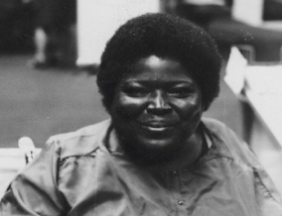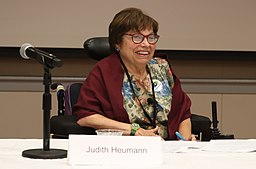1.4 Deinstitutionalization
As intended, the CMHA was instrumental in the movement and process that came to be known as deinstitutionalization. Deinstitutionalization was, first, the dramatic downsizing and closure of the large institutions, mainly the state hospitals, that had been housing patients with mental disorders for a hundred years. The other half of this process was, or should have been, moving those same people into communities where they could receive care, support, housing – all the things they needed to survive and thrive outside of institutions. On the second front, deinstitutionalization was, at least in part, a disappointment.
As state hospitals across the country reduced their bed space, many people were discharged into their communities – including people who likely never had significant reason to be hospitalized, and people who experienced serious mental illness and significant disabilities. Prior to the start of the deinstitutionalization process, in 1955, there were around 550,000 mentally ill and disabled patients institutionalized at public hospitals. Twenty years later, in 1975, the number was down to 200,000. By 2017, there were less than 40,000 such patients in state hospitals. Based on the straight numbers, but especially in light of the significant U.S. population increase during these decades, the percentage of people being hospitalized for mental disorders had plummeted (Substance Abuse and Mental Health Services Administration, 2019).
As a social movement, and in its best light, deinstitutionalization marked the beginning of treating people with mental disorders as something more than patients, or problems to hide away. People who had been confined against their wishes for lengthy periods emerged as people and community members. With medications, treatment and other supports available outside of institutions, these people finally had the opportunity to live in their own homes and communities. Though inherent in this change was the concern that it would not succeed, and that people would suffer, the opportunity for growth and independence makes that risk worthwhile. Allowing people with mental disorders to seek lives in the community gave them the dignity of risk, that is, the ability to potentially fail that comes along with an opportunity for growth. The concept of dignity of risk was first introduced by scholars in the 1970s and 80s, but has become a central tenet of self-advocates who argue that many forms of perceived “protection” place unacceptable limits on the lives of people with disabilities. The concept and importance of dignity of risk is explained by a self-advocate in figure 1.15.
Figure 1.15. Dignity Of Risk [YouTube Video]. Watch this short video where a self-advocate explains the concept of dignity of risk, and consider how that may impact your opinions about deinstitutionalization.
Deinstitutionalization was not just a medical development or a legal maneuver. It was also part of a larger change in thinking that was pushed forward by the budding disability rights movement, which was part of the larger civil rights movement taking place in the mid-1900s in America. The disability rights movement was a broad push towards securing equal rights and opportunities for people who experience disabilities. Disability advocates saw other groups – people of color and women – asserting their rights to fair treatment under the law, and realized that people with disabilities also needed to claim their rights. Groups such as disabled veterans and polio survivors were visible and often sympathetic leaders in this movement, as were parents of disabled children fighting for access to educational opportunities (ADL Education, 2022).
As part of the disability rights movement, there was increasing discomfort with the previously accepted marginal role of people with disabilities (including mental disorders) in society. Activists were claiming that people with disabilities had rights as free human beings, and that barriers would not be tolerated. These activists wanted, and argued they were entitled to, live in accessible communities, with a degree of autonomy. All of this applied to people with mental disorders.
The disability rights movement was first organized and led primarily by white people with physical disabilities. People with psychiatric disabilities or intellectual disabilities, and people of color with any disabilities, were less socially favored and often excluded from the mainstream of the disability rights movement (Erkulwater, 2018). The disability rights movement was diverse in some ways – bringing together people from all walks of life, children and adults, veterans and hippies – but it struggled to fully integrate many other voices that would have increased its power and traction. This remains true to the present day, and the reasons are not always clear. One scholar who studies this issue has suggested that comparisons of suffering were harmful to group cohesion and to people of color who needed their experiences to be seen fully:
“White activists with disabilities sometimes argued that Blacks had to sit at the back of the bus, but the disabled couldn’t even get on the bus. That argument erases Black people with disabilities, whose exclusion is the result of both racism and ableism. When advocating for human rights, it’s important to recognize that our movements include people of marginalized identities, and there is value in centering those experiences and perspectives” (Erkulwater, 2022).
1.4.1 SPOTLIGHT: Women Who Shaped the Disability Rights Movement
As discussed in the main text, the disability rights movement was instrumental to the deinstitutionalization process for people with mental disorders. Even before that time, advocates who championed the rights of those with mental illness and disability set the stage for this piece of the civil rights movement. Even into the present day, advocacy of people with disabilities and their allies remains central to maintaining freedom and access for all people with disabilities, including mental disorders. Among some of the interesting and impressive disability advocates are numerous women:
- Bessie Virginia Blount (1914–2009) was born in Hickory, VA (figure 1.16). As a child of free Black people, she was sent to a very small segregated school that only taught through sixth grade. She had no opportunities to further her education until she was accepted to Union Junior College in Cranford, NJ. She studied nursing and later became a licensed physiotherapist. During WWII, Blount volunteered at military hospitals and realized that helping those with disabilities was her passion. She is credited with developing one of the earliest forms of assistive technology to improve the quality of life for those who could not feed themselves.

- Johnnie Lacy (1937–2010) was born in Huttig, AR, but moved to California when she was very small (figure 1.17). At the age of 19 she was diagnosed with polio, which left her paralyzed for the rest of her life. After being treated in a rehabilitation facility, she was able to go to college and earn a degree. While in college she faced discrimination for being Black, female, and disabled. She eventually helped found the Center for Independent Living at Berkeley and became the Director of Community Resources for Independent Living from 1981 to 1994.
- Judy Heumann (b. 1947) was diagnosed with polio at just 18 months (figure 1.18). Due to being in a wheelchair and considered a “fire hazard”, Judy had to spend her early life fighting to attend public school. It wasn’t until fourth grade that she was able to attend a school for disabled children, but city policy required that she be home-schooled for high school. Another fight ensued, and that policy was eventually reversed. While attending Long Island University, Judy became very active in increasing the rights of people with disabilities. She organized rallies and protests. After college, she did not give up the fight. In 1977, Judy staged a sit-in when the U.S. Secretary of Health, Education and welfare refused to sign regulations for Section 504 of the Rehabilitation Act of 1973, which protected civil rights for people with disabilities (discussed in more detail in Chapter 3). To this day, the 504 sit-in, lasting 28 days, is the longest ever sit-in at a federal building.

Norwood, A.R. (2017). Dorothea Dix. National Women’s History Museum. Retrieved from https://www.womenshistory.org/education-resources/biographies/dorothea-dix.
Honoring Black History Month: Unsung Heroes of the Disability Rights Movement. (2021). Natonal Center for Learning Disabilities. Retrieved from https://www.ncld.org/news/honoring-black-history-month-unsung-heroes-of-the-disability-rights-movement/.
Rosemary Kennedy. (2022). John F. Kennedy Presidential Library and Museum. Retrieved from https://www.jfklibrary.org/learn/about-jfk/the-kennedy-family/rosemary-kennedy.
Judith Heumann. (2022). Wikipedia. Retrieved from https://en.wikipedia.org/wiki/Judith_Heumann.
1.4.2 Licenses and Attributions for Deinstitutionalization
“Deinstitutionalization” by Anne Nichol is licensed under CC BY 4.0. Reliance on “Psychology 2e, 16.1- Mental Health Treatment: Past and Present ” by R. M. Spielman, W. J. Jenkins & M.D. Lovett, which is licensed under CC BY 4.0. Access for free at https://openstax.org/books/psychology-2e/pages/1-introduction.
Figure 1.15. “Dignity of Risk” by UVM Center on Disability & Community Inclusion is licensed under the Standard YouTube License.
“SPOTLIGHT: Women Who Shaped the Disability Rights Movement” by Monica McKirdy is licensed under CC BY 4.0.
Figure 1.16 – photo of Bessie Blount – included under fair use. Access at https://www.blackpast.org/wp-content/uploads/Bessie_Blount_Griffin.jpg.
Figure 1.17 – photo of Johnnie Lacy – included under fair use. Access at https://www.centerforlearnerequity.org/wp-content/uploads/lacy.png.
Figure 1.18 – photo of Judy Heumann – licensed under CC BY 4.0. Access at https://commons.wikimedia.org/wiki/File:2019-Jul-25-TASH-OLDL-Judy-Heumann.jpg.
